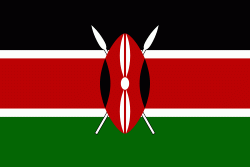Laikipia District (Laikipia)
Economic activities in the county consist mainly of tourism and agriculture, chiefly grain crops, ranching and greenhouse horticulture.
The county encompasses the high, dry Laikipia Plateau, and has a cool, temperate climate with both rainy and dry seasons. The county borders Nyandarua, Nyeri, Samburu and Baringo counties.
Laikipia county has a total population of 518,560 of which 259,440 are males, 259,102 females and 18 intersex persons. There are 149,271 household with an average household size of 3.4 persons per household and a population density 54 people per square kilometre.
Map - Laikipia District (Laikipia)
Map
Country - Kenya
 |
 |
| Flag of Kenya | |
Kenya's earliest inhabitants were hunter-gatherers, like the present-day Hadza people. According to archaeological dating of associated artifacts and skeletal material, Cushitic speakers first settled in Kenya's lowlands between 3,200 and 1,300 BC, a phase known as the Lowland Savanna Pastoral Neolithic. Nilotic-speaking pastoralists (ancestral to Kenya's Nilotic speakers) began migrating from present-day South Sudan into Kenya around 500 BC. Bantu people settled at the coast and the interior between 250 BC and 500 AD. European contact began in 1500 AD with the Portuguese Empire, and effective colonisation of Kenya began in the 19th century during the European exploration of the interior. Modern-day Kenya emerged from a protectorate established by the British Empire in 1895 and the subsequent Kenya Colony, which began in 1920. Numerous disputes between the UK and the colony led to the Mau Mau revolution, which began in 1952, and the declaration of independence in 1963. After independence, Kenya remained a member of the Commonwealth of Nations. The current constitution was adopted in 2010 and replaced the 1963 independence constitution.
Currency / Language
| ISO | Currency | Symbol | Significant figures |
|---|---|---|---|
| KES | Kenyan shilling | Sh | 2 |
| ISO | Language |
|---|---|
| EN | English language |
| SW | Swahili language |















